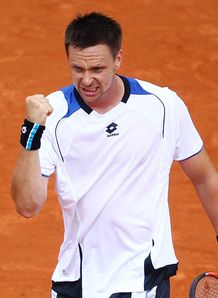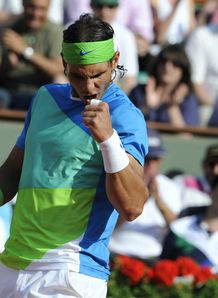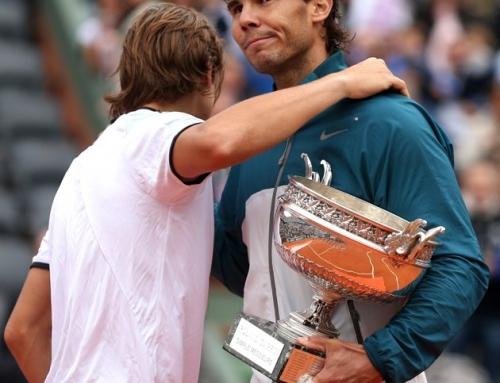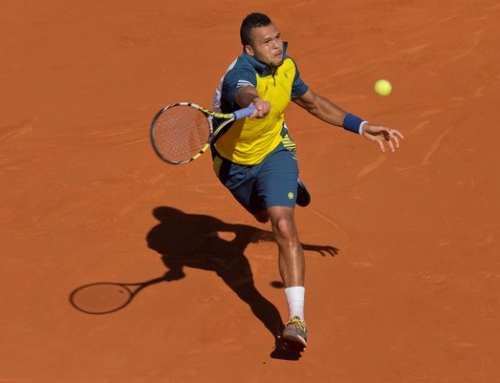
 Lleyton Hewitt was once asked who his tennis idol was. Rather than point to one of the numerous Aussies, many of whom had probably stopped playing by the time he was born, or even to players like Pat Cash, his role model was the Swede, Mats Wilander. Perhaps it made more sense, especially since Hewitt wanted to be a baseliner, a wise choice given the way the game headed during Hewitt’s playing years.
Lleyton Hewitt was once asked who his tennis idol was. Rather than point to one of the numerous Aussies, many of whom had probably stopped playing by the time he was born, or even to players like Pat Cash, his role model was the Swede, Mats Wilander. Perhaps it made more sense, especially since Hewitt wanted to be a baseliner, a wise choice given the way the game headed during Hewitt’s playing years.
Mats Wilander also did not choose the obvious choice for a role model. Instead of picking Swedish icon, Bjorn Borg, he picked the brash American, Jimmy Connors. Who would have known that as Wilander got older, this brashness would manifest itself in his personality, and he would like the limelight, and opine his opinions about this and that. Life of a former pro.
Robin Soderling finds himself in an unenviable position. He probably feels Andy Murray’s pain. As the sole highly ranked Swede, he is the only guy Sweden that’s ranked in the top 300. There are more Swedish players ranked 900 and worse than ranked 900 and better. But prior to the French Open last year, he was considered a good solid, but mentally erratic, pro. Wilander would say, he might not play well in tournaments, but he was always a Davis Cup stalwart, a guy who won matches against good players.
Prior to his French Open success, I had not heard of Robin Soderling, even though he was ranked in the top 50 since about 2006 (before I started watching tennis seriously) and very often in the top 30, I had never seen him play until I heard him upset Rafa. Afterwards, Wilander would say that the most improved shot in tennis (admittedly, not a real category of awards, which I would love to see) was Robin Soderling’s mind.
At the time Soderling broke through by beating Rafael Nadal, some might have (unwisely) considered it a fluke. Indeed, if you passively paid attention to tennis in the next 6 months, you might say, what happened to Robin Soderling? You’d, of course, be one of those fair-weather fans that only care about finalists or semifinalists. Soderling took that victory and made himself into a solid top 10 player. Sure, he didn’t get into any Slam final, but he ran into Roger Federer at Wimbledon and the US Open. Had he not done so, perhaps he’d have reached the quarterfinals or at least, gone a step further. It’s hard to keep facing the number 1 player every Slam you play.
But the real evidence that Soderling’s mental prowess had already taken a leap was his next few matches. Soderling demolished Nikolay Davydenko in the quarterfinals. Although Soderling was something of an unknown at that point, and although Dayvdenko had made short work of Fernando Verdasco, in the fourth round, Soderling had a winning record over Davydenko who was making his comeback after an injury earlier in the year (of 2009–obviously, Davydenko is still injured this year). Even so, Davydenko was a seasoned pro, ranked as high as 3 in the world. For Soderling to come through there, especially after such a huge victory showed a mental focus that was once lacking.
But where Soderling really made his mark was in the semifinals against the hard hitting Fernando Gonzalez. It say something when you are down 2 breaks in the 5th, and then you get out of that to win the match in 5 sets. Soderling admittedly went away tamely against Roger Federer in the final, but against players of his own caliber, Soderling showed an amazing resilience and fight. Few people had heard of Soderling. With McEnroe exclaiming that Soderling was not well-liked on the tour, Soderling gave a very gracious and light-hearted post-match interview, and did a lot to give the impression that he was a happy Swede, even if past behavior suggested otherwise.
It also says something that Robin Soderling, a year later, was considered Roger Federer’s biggest threat to win the French title. Note that Soderling had never beaten Federer, with a 12-0 win-loss record. Yet, Soderling never let that weighty record bother him. He said he was a bit unlucky that he hadn’t beaten him before. If he served well, he had his chances. And, once he finally got that monkey off his back, Soderling needed to get past one other guy that had given him trouble before, Tomas Berdych. In the end, Soderling’s focus, and Berdych fading serve, allowed Soderling to come back in 5 sets and make his second straight French final.
What a difference a year makes. Last year, Nadal came into the French, still the hottest player on clay. He had just won the Australian Open earlier in the year. He was number 1 in the world. The only blip was a loss to Roger Federer in the Madrid finals, a match where Nadal had chances to win. Still, few thought Federer had solved Nadal. There was some worry whether Federer could win in 5 sets over Nadal.
Nadal was progressing as he usually does until he met Robin Soderling, who proceeded to outhit a nervous Nadal. Nadal had his chances, especially after taking a set. Give credit to Soderling for being able to close out the deal.
At that point, Nadal pointed out that his knees were bothering him, and that he had had knee tendinitis, and he was unsure whether he’d be able to play Wimbledon. He played some exhibitions, lost to Hewitt and Wawrinka, and decided to take a trip to Mallorca where he would heal and he’d be off for about 2 months until Montreal and Cincinnati. He’d lose somewhat early in both these tournaments, but claim that he might be a little rusty.
In the semifinals, he’d replicate his 2008 results and get to the semifinals where he was just demolished by Juan Martin del Potro, in a score of 2, 2, and 2. Unlike past year, Nadal was pretty healthy heading into the tournaments after the US Open. Even so, he struggled to win tournaments. He’d reach finals, but not quite win them.
He lost in a semifinal to Marin Cilic in Beijing, lost in the finals to Davydenko in Shanghai (when Davydenko was starting to play some of his best tennis), and lost in the semis of Paris to Djokovic. Nadal’s low point was the ATP World Tour Finals where he went 0-3 in the round robin, losing to Djokovic, Davydenko, and Soderling. Indeed, the 3 players that had given him the most trouble all year long (minus del Potro) were in this group.
Nadal then took a break until January as most players do. In Doha, Nadal again played Davydenko. This was a more aggressive Nadal. After a 6-0 bagel against Davydenko, Davydenko clawed back, holding serve, and went into a tiebreak, where he had to save match points. Once he won that tiebreak, he won the third set with a break, and really, a mental lapse on Nadal’s part. That sharp focus that kept Nadal at the top of the game faded a bit, and Davydenko, once considered mentally fragile, played focused power tennis, and beat Rafa once again.
In the Australian Open, Andy Murray’s ranking, which had been as high as number 2 during Rafa’s absence, had slipped to 5. Because he wasn’t in the top 4, he could meet any of the top 4 seeds as early as the quarterfinals. Murray ended up drawing Rafa in the quarterfinals. He attacked Rafa and took the first two sets and was up 3-0 in the third, before Rafa retired with an injury.
Rafa then took yet another long break, not playing again until Indian Wells. Again, it looked like he was playing pretty well, got to the semifinals, won the first set against Ivan Ljubicic, but Ljubicic used his big serve to hold serve and pushed hard for a break to win the 2nd set. From that point, Nadal’s confidence seemed to drop while Ljubicic’s went up and he kept even with Rafa until a tiebreak, which he dominated. He would then play Roddick in the final to win his first Masters 1000 title ever, at the age of 31.
Rafa went to Miami and again had similar results. He reached the semis, took the first set against Roddick, before Roddick served better, and then decided to move from his consistent rally style to his “go for broke” style. This seemed to have caught Rafa off-guard, and Roddick was able to break and take the second set. Unable to adjust properly, Roddick continued to play aggressive tennis and got another break and won that semifinal encounter.
By that point, Rafa had basically been reaching quarterfinals, semifinals and finals, but had yet to win a tournament. So, by the time he reached Monte Carlo, his last title was nearly a year earlier, in Rome. Honestly, if any other player could consistently reach the quarters, semis, and finals of most tournaments, they’d be in the top 15 in the world, perhaps even the top 10. Of course, clay rejuvenated Rafa, and he won all 3 Masters 1000 events heading into Paris. Rafa’s new strategy was to go for bigger shots, and risk more errors, with the idea being that he needed to preserve his body so he could play year round. He could only play his grinding safe style for so long and it had already taken its toll on him.
So he we are. In the finals. I think it’s safe to say most people still favor Rafael Nadal to win his fifth French Open. He’s yet to drop a set. He’s played high-level clay court tennis since Monte Carlo. He hasn’t played at the extraordinary high level he did in Monte Carlo, having been pushed to tiebreaks against Almagro and Melzer in the last two rounds. Melzer came as close as anyone to taking a set from Nadal.
Given Nadal is the favorite, and a good solid match would probably win it for Nadal, how can Soderling beat Nadal? Let’s go through the list of players that have beaten Nadal in the last year or so: Federer, Djokovic, Murray, Cilic, Davydenko, del Potro, Roddick, Ljubicic, Soderling. Generally, the way you beat Nadal is to overpower him. You need a big serve so that you get a few free points on serve. Davydenko’s serve has improved a fair bit over the years, so he now gets free points. Once you can hold your own serve reasonably well, you can start putting pressure on Nadal’s serve. The clay favors Nadal because he gets many more chances to break serve.
You need to be able to hit hard enough to hit winners, and yet be quick enough and consistent enough to keep in the rallies with Nadal. Many lower ranked players can’t handle Nadal because they can’t keep up with him off the ground. Players like John Isner are often a little too slow to reach Nadal’s shots. Nadal doesn’t go for winners (mostly), but hits hard shots that you barely reach, which is good enough. You put up a defensive shot, and he takes advantage. Melzer had this problem. Rafa would attack Melzer’s backhand and he would have to hit a slice just to stay in the point.
Last year, Rafa was playing more nervous, so he’d play many more shots up the middle, and you’d have a chance to stay in the point. Rafa had always had the ability to play bigger tennis, but he always favored fewer unforced errors and a safer style. In the last few months, he’s adjusted his play to be much more aggressive, and with it, he’s making more errors, but he’s also winning points more easily.
Melzer then had to play more aggressively. This is common against Nadal. You realize that your regular shots aren’t bothering Nadal and he’s taking advantage of them. So you go for bigger shots just to stay even. You hit hard even when you shouldn’t. And yet, Nadal is able to chase down many of these hard shots. For every point you play this aggressively, you might win a quarter of the points outright. Then, half the points, Nadal continues making you play 2, 3, or 4 more shots and maybe you win then and maybe you don’t. And finally, you miss the other quarter of the shots because these are shots you aren’t used to hitting.
Out of the players mentioned, I think only one player has a “Nadal strategy” that he’s gotten to work, and that’s Andy Murray. Murray generally has a more passive style of playing, but against Nadal, he gets more aggressive and it has paid off in the past. Murray learned to hit a short angled crosscourt forehand that would force Nadal to play his backhand. Nadal is often more passive on his backhand, but nowadays, with Nadal standing in so close to the baseline, he’s learned to play a hard crosscourt shot, rather than a neutral shot up the middle. That neutral shot up the middle often opens up an inside-out shot to Nadal’s forehand. Nadal has often had a tougher time going to his left, and so this has been a go-to play for most players looking to beat Nadal.
Players like del Potro and, indeed, Soderling, have had success against Nadal, because the power strategy is how they play all the time. When Melzer has to take big cuts against Nadal, he’s going to make more unforced errors because he doesn’t play that style all the time.
Davydenko, being a shorter guy, took a different strategy. He likes to play right at the baseline or closer, when he can (obviously at the pro level, even Davydenko can be pushed way behind the baseline, but he’ll quickly move in). Davydenko can play great angles, and by doing so, he would push Nadal way off to his right. Nadal would play a neutral shot up the middle or even a decent crosscourt, and Davydenko would hit a shot up the line. Since Davydenko is not standing meters behind the baseline, he robs Nadal of time to reach the shot (and in any case, Nadal runs worse to his left). You could consider Davydenko’s style a hybrid between typical baseline play and serve and volley.
Of course, this is mostly a happenstance of tennis history. Davydenko stands where most players used to stand. Once the game became as powerful as it is now, many players started standing way back, many meters behind the baseline. Indeed, one criticism of Murray is just how far back he likes to stand. One advantage Nadal has is total faith in his coach, Uncle Toni. Male pros are traditionally very conservative. They don’t like to change what’s working. But if Uncle Toni wants Rafa to play closer to the baseline, then Rafa is playing closer to the baseline. He just has the kind of talent to make that work. But it makes Davydenko’s strategy seem more like a “serve and volley” ploy because he takes a fraction of a second away from his opponents.
The only player in the one listed that isn’t a guy that hits tons of winners, who plays steady like Nadal, and still has won matches against him, is Novak Djokovic. Think about all the players that normally beat Nadal. They use a fair bit of power. There are maybe 3 exceptions to this. Davydenko, who stands in very close, and robs Nadal of time, and yet is very accurate when going for a big shot. Andy Murray, who tries to attack Nadal more, but otherwise isn’t going for big winners. And Novak Djokovic, who likes to work around the point.
So this leaves a player like Soderling. Soderling is the basher type. He has a big serve, and he takes big swipes. His one weakness is similar to del Potro. Soderling isn’t a great mover. There are two things you need in tennis, and you need more of one if you have less of the other. You need to be quick, and you need to hit hard. If you’re not quick, you better hit hard. If you can’t hit hard, you better be quick. Recent history suggests hitting harder works better in the long run. Speed only helps you so much. A player like Ivo Karlovic is on the pro tour because he has power, but not much speed. Isner is the same. Big man tennis is about power serve and power forehand and not having a backhand that’s a weakness.
Soderling is closer to the del Potro mold. Big serve, but both big forehand and big backhand. Soderling also breaks a lot of “directionals” when playing. Soderling loves hitting down the line. He doesn’t prefer the standard crosscourt exchanges, and that is a little unusual for a top player. Soderling, of course, believes he can beat Nadal. The thing that’s different between Nadal of previous years and Nadal of today is his more aggressive stance.
Will this be better for Soderling? On the one hand, Nadal will get a few more shots back and angle them for winners. On the other, Nadal gives himself less time to react to the ball and will make more errors. Federer, by contrast, in his match against Soderling didn’t pressure the Swede that much. He played a lot of shots up the middle and let Soderling have a chance to hit the ball. The Berdych match might be somewhat helpful to Soderling because Berdych hits a hard ball, and that robbed Soderling of time. To be fair, Berdych also hits very flat like Soderling (perhaps even flatter than Soderling) which is unlike Nadal who hits with a lot of topspin.
So I don’t think it’s a foregone conclusion that Nadal will win. Of all the players playing, outside of Federer, I think Soderling was the one guy that had a decent shot of beating Nadal. He’s actually not played Nadal since the beginning of the year (in an exhibition), and not since the ATP World Tour Finals (officially) which he won. Nadal is a new man since then, and it’s hard to say whether that favors Nadal or much. I think it does mean that Nadal won’t give as many neutral balls as he normally does, which often helps an opponent who wants to attack him.
In the end, I think it will come down to Soderling’s mind. Will he believe in his own game, and push Nadal around. We’ll find out on Sunday!




![[French Open] The tactics of the Djokovic-Nadal semifinals](https://www.essentialtennis.com/wp-content/uploads/2013/06/20130607nole-500x383.jpg)
![[French Open, SF] David Ferrer defeats Tsonga in straight sets to reach first Slam final](https://www.essentialtennis.com/wp-content/uploads/2013/06/20130607ferrer-500x383.jpg)
![[French Open, SF] Nadal escapes epic 5-setter with win over Djokovic, to compete for 8th title](https://www.essentialtennis.com/wp-content/uploads/2013/06/20130607rafa-500x383.jpg)
